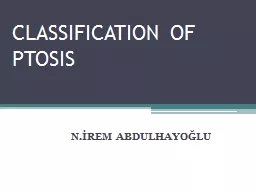

NİREM ABDULHAYOĞLU Blepharoptosis or ptosis is defined as drooping of the upper eyelid Can affect all age groups and may be congenital or acquired ID: 911732
Download Presentation The PPT/PDF document "CLASSIFICATION OF PTOSIS" is the property of its rightful owner. Permission is granted to download and print the materials on this web site for personal, non-commercial use only, and to display it on your personal computer provided you do not modify the materials and that you retain all copyright notices contained in the materials. By downloading content from our website, you accept the terms of this agreement.
Slide1
CLASSIFICATION OF PTOSIS
N.İREM ABDULHAYOĞLU
Slide2Blepharoptosis or ptosis is defined as drooping of the upper eyelid
.
Can affect all age groups and may be congenital or acquired.
Slide3Anatomy
The muscles responsible for eyelid
retraction:Levator palpebrae superioris;
under voluntary control from CN III.Müller's muscle; contributes 1-2 mm of eyelid elevation and
i
t
is under sympathetic
innervation
.
F
rontalis
muscle
;
lifts the brows and is a minor contributor to eyelid
retraction
a
nd
i
t
is innervated by CN
VII
.
Slide4Slide5Classification
A.
CongenitalB. Acquired 1.Neurogenic 2.Myogenic 3.Aponeurotic 4.Mechanical
C. Pseudoptosis
Slide6A.Congenital Ptosis
Simple congenital ptosis
weakness of levator muscle most cases are this type when patient born with this problem
most often sporadic but can be inheritedCongenital ptosis with weakness of superior rectus muscle(the muscle that makes the eyeball look up)about 1 in 20 cases have the added eye muscle weaknessPtosis with blepharophimosis syndromedominant hereditary conditionSynkinetic
ptosis
involuntary motion of eyelid with attempted desired motion
Marcus-Gunn jaw winking ptosis
misdirected
3rd nerve ptosis
Slide7Blepharophimosis syndrome(BPES)
narrowing of the eye opening
(blepharophimosis)droopy eyelids (ptosis)
upward fold of the skin of the lower eyelid near the inner corner of the eye (epicanthus inversus) increased distance between the inner corners of the eyes (telecanthus)
Slide8Marcus Gunn
jaw-winking syndrome (Congenital Trigemino-oculomotor synkinesis)Characterized by eyelid
synkinesis with jaw movement.Accounts for about 5% of all cases of congenital ptosis.
Slide9B.Acquired Ptosis
1. NEUROGENIC PTOSIS
Oculomotor nerve palsy Horner’s syndrome
Myasthenia gravis Synkinetic ptosis Guillain-Barré syndrome Cerebral
ptosis
Botulism
Slide10Oculomotor nerve
palsy
Characterized by a variable degree of ptosis associated with deficits
of adduction, elevation, and depression of the
eye
due
to
weakness
of
the
levator
muscle
,
the
superior
,
inferior
and
medial
rectus
muscles
and
the
inferior
oblique
muscle
.
Palsy
may
be
caused
by
neoplastic
,
inflammatory
,
vascular
or
traumatic
lesions
.
Slide11Patients may present with any combination of ptosis, ophthalmoplegia, diplopia, and a poorly-reactive dilated
pupil
.
Slide12Horner's syndrome
(
oculosympathetic paresis)Ptosis (1-2mm)MiosisFacial anhidrosisEnophtalmos
Damage anywhere along the sympathetic pathway; -first order neurons (hypothalamus to spinalcord
)
-
second order neurons (spinal cord to superior cervical ganglion
)
-
third order neuron (superior cervical ganglion to orbit)
Slide13Myasthenia gravis
I
n 85% of patients with myasthenia, the initial symptoms were either ptosis or diplopia.Bilaterally or unilaterally Ptosis
can change on a minute-to-minute basis. Classically the ptosis is more severe in the evening.
Slide14Cogan's
lid
twitch: rapid saccades from downgaze to the primary position may provoke an overshoot
of the upper eyelid.Tensilon test(edrophonium chloride):
Tensilon
is a
short
acting
anticholinesterase
agent
and
it
will
temporarily
overcome
the
muscle
weakness
Slide152.
MYOGENIC PTOSISCongenital dystrophy of the
levator muscleMyotonic dystrophyChronic progressive external ophtalmoplegiaTraumatic
Slide16Myotonic dystrophy
A defining feature of the disease is
myotonia, or a failure of the muscle to relax. Eventually leads to facial and peripheral muscle weakness. Christmas
tree cataracts Frontal balding Intellectual impairment
Slide17Chronic progressive external
ophthalmoplegia
(CPEO)Mitochondrial myopathy Symmetric, bilateral ptosis and ophthalmoparesis typically in their 30'sKearns-Sayre
syndrome : CPEO and retinitis pigmentosa
Slide183.
APONEUROTIC PTOSIS
Defects in the levator aponeurotic linkage(between the
levator muscle and the tarsal plate) in the presence of a normal functioning muscle. Involutional
(
senile
)
Postoperative
Post
eyelid
trauma
Post
eyelid
edema
Post
contact
lens
wear
Slide19Involutional ptosis
Ptosis
that is constant in all position of gazeLid drop on downgaze
Good levator functionHigh skin creaseThinning of the eyelid
Slide204.
MECHANICAL PTOSISDue to excessive weight on the upper lid; Eyelid tumors Orbital lesions
Cicatrizing conjunctival disorders
Slide21C.Pseudoptosis
The eyelid appears to be lowered but there is no pathology of the eyelid muscles or aponeurosis. Contralateral eyelid retraction Hemifacial spasm
Dermatochalasis(an excess of skin in the upper eyelid)/brow ptosis Aberrant reinnervation
of
the
facial
nerve
Double
elevator
palsy
Slide22REFERENCES
Oculoplastic
Surgery - Brian LeatherbarrowGöz Hastalıkları - Gerhard K. Langhttps://www.aao.org/eye-health/diseases/ptosis-treatmenthttp://
webeye.ophth.uiowa.edu/eyeforum/tutorials/ptosis/index.htm
Slide23Thank you…